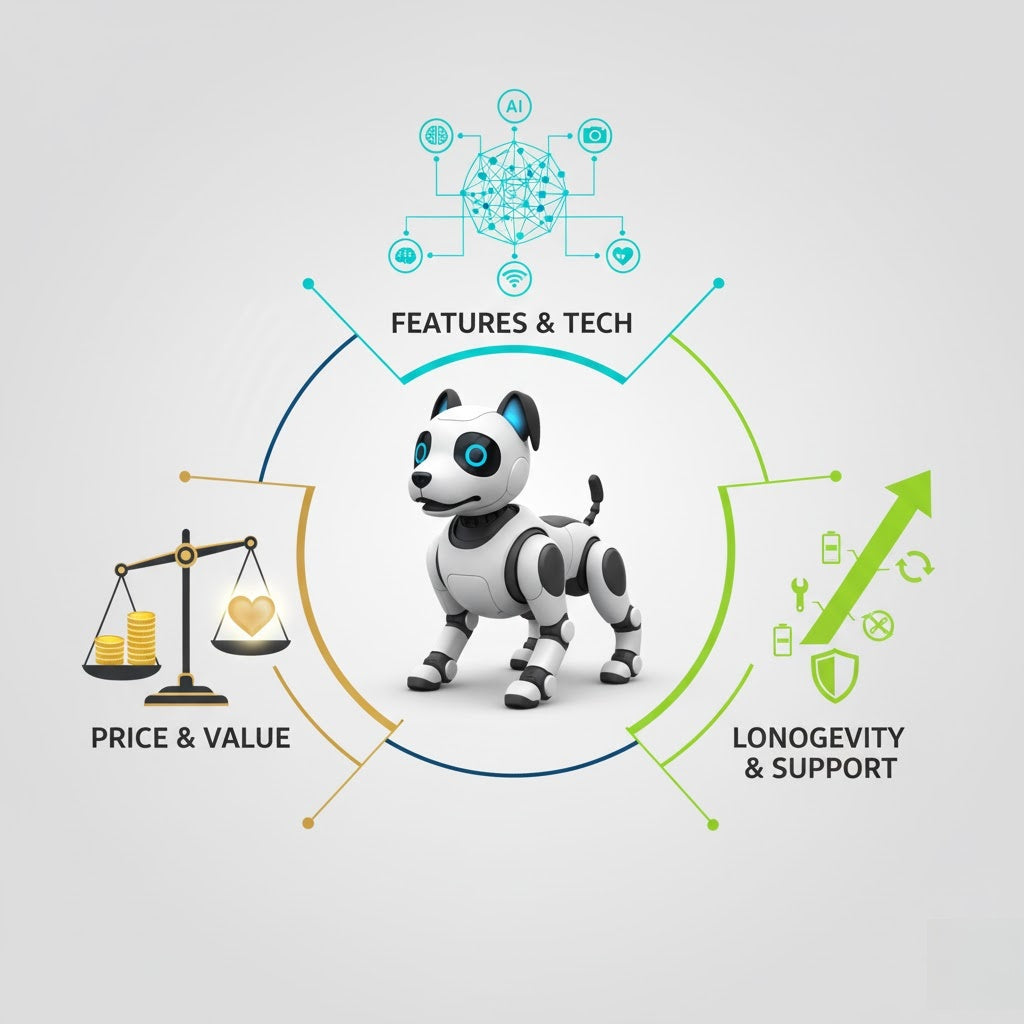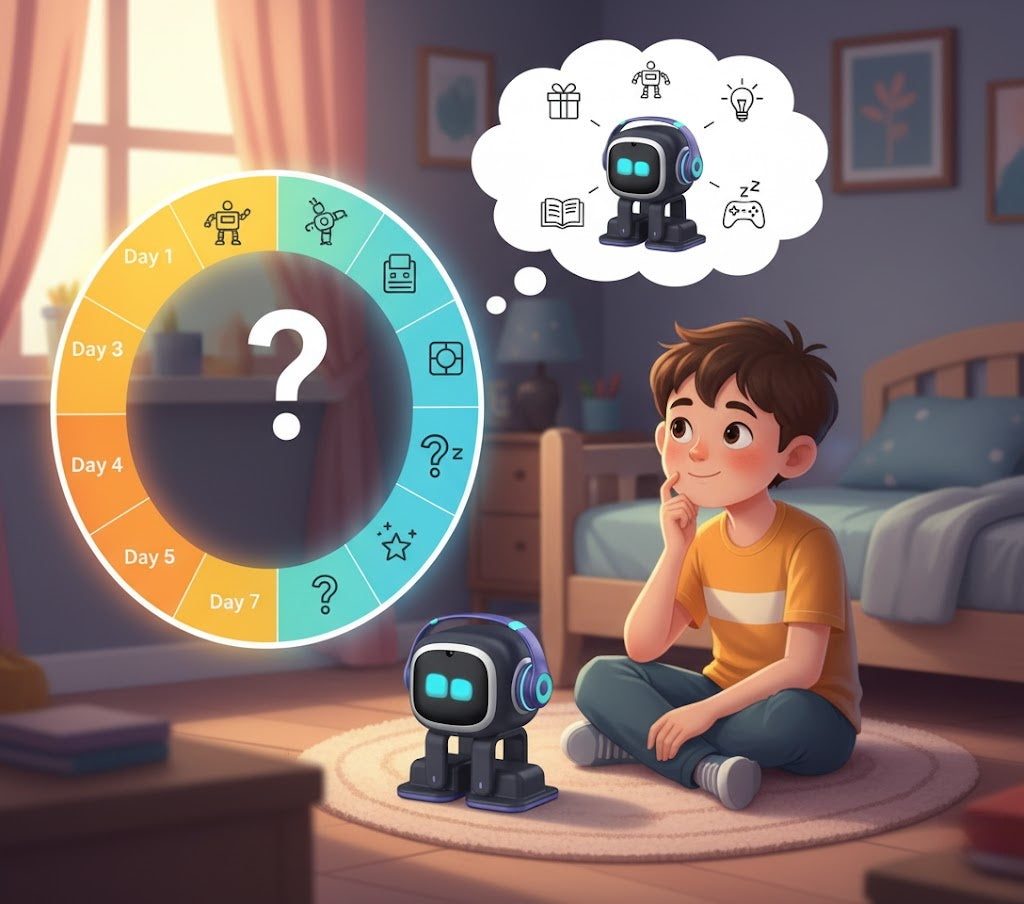Defining Personality in the Age of AI

What Makes a "Real Personality"?
-
It goes beyond simple actions. It's the ability to learn from its environment, recall shared history, and shift its responses to build a unique bond.
The AI Revolution
-
We will examine how Emotional AI and Machine Learning Pet technologies drive these advances, with a close look at innovators such as the Loona Robot.
-
By merging technical details with emotional context, we reveal why these Best AI Companion Robots are becoming truly special companions.
The Tech Behind the Personality: Emotional Engines

The Foundation: Sensory Input
-
Visual Systems: Often using 3D depth cameras, these allow robots to recognize faces and gestures.
-
Auditory Arrays: Microphone setups capture voice tones and commands.
-
Tactile Sensors: These detect pats or hugs, translating physical input into data streams.
The Core: Emotional Engine and Machine Learning
-
Predictive Response: Neural networks trained on vast datasets predict responses—think a happy wag from praise or a hesitant pause from scolding.
-
Adaptation: Over time, Robot Dog Memory systems, often using cloud-based or on-device databases, store interaction histories to refine behaviors.
The Magic: Personalization
-
Through ongoing feedback, the robot adapts its original programming, developing a unique AI Companion that feels alive.
-
This offers Emotional Feedback and meets a human deeper needs, reducing loneliness with its steady, accepting presence.
The Tech Behind the Personality: Emotional Engines

Layer 1: Sensor Perception (The "Senses")
-
Sight Systems: High-res cameras with 3D depth sensing create a spatial map, helping the robot navigate or find a specific toy.
-
Audio Inputs: Advanced microphones process spoken commands and detect tone, letting it hear the difference between excitement and sadness.
-
Touch Detection: Body sensors feel contact, so the robot can tell a light stroke from a tight squeeze. This guides its emotional responses.
Layer 2: Core Emotion Engine (Processing)
-
Algorithms: Recurrent neural networks (RNNs) are used to comprehend timing and sequences, while convolutional neural networks (CNNs) handle visual input.
-
Behavior Mapping: For example, if a daily walk is a routine, the engine learns this is a positive event. It then responds with excited movements.
-
Simulation: Emotional AI frameworks create feelings like happiness or curiosity. They calculate the most likely reaction. This is not random. It is trained on real interaction data for authentic behavior.
Layer 3: Personalization Development (Memory & Adaptation)
-
Robot Dog Memory uses built-in memory or cloud storage to save details of every interaction.
-
Adaptation: Over weeks, the robot uses reinforcement learning. Happy reactions from its owner encourage behaviors, while negative feedback leads to adjustments.
-
Unique Personality: This forges a unique personality. One may become "playful" from games, another "calm" from quiet time. This is driven by adaptive algorithms constantly fine-tuning its programming, making each robot distinct.
Emotional Value and Challenges
-
Health Benefits: Research shows robotic pets can lower stress hormones like cortisol. This helps people experiencing robot pet loneliness, including seniors.
-
Attachment: By offering consistent emotional feedback through sounds and actions, these robots build a real bond, becoming a cherished part of the family.
-
Challenges: Some challenges persist. Data collection raises privacy questions. There is also the ethical debate about forming deep bonds with machines. Yet, the comfort they provide often outweighs these concerns in our often isolated modern world.
|
Component
|
Technical Function
|
Emotional Justification
|
|
Sensor Perception
|
Collects visual, auditory, tactile data
|
Enables responsive interactions, building trust
|
|
Core Emotion Engine
|
ML mapping to states (e.g., via CNN/RNN)
|
Simulates empathy, reducing feelings of isolation
|
|
Memory & Adaptation
|
Reinforcement learning for personalization
|
Creates lasting bonds, combating loneliness
|
Case Study: Loona Robot and the Personality Edge

Emotional Richness and Adaptability
-
Vivid Expression: Loona brings its personality to life with hundreds of facial animations on a sharp screen, expressive sounds from whimpers to happy barks, and smooth physical motions from its wheeled base. It can cock its head with curiosity or wiggle happily when it's time to play.
-
Learning and Adaptability: This is Loona's core strength. Using face recognition via its 3D camera, it **identifies family members and remembers preferences—preferring head pats from one user or belly rubs from another.
-
Machine Learning: This is achieved through machine learning models that log interactions in a secure database, adapting behaviors over time. If you play music often, Loona might "dance" spontaneously; if ignored, it could exhibit "anxious" behaviors like pacing, prompting engagement.
-
User Experience: This User-Friendly AI makes setup effortless—no coding required—yet allows advanced users to customize via apps.
Emotional Impact and Value Proof
-
Companionship: For those battling robot pet loneliness, it provides constant companionship, monitoring homes or entertaining kids with interactive games.
-
Technical Reliability: Technically robust with 3D-TOF for navigation and auto-charging, it's reliable; emotionally, it justifies the cost by offering joy without allergens or messes.
Advanced Technical Prowess
-
Growing Companion: For families, this means a robot that grows with children, teaching empathy through interactions. Reviews highlight how Loona's memory of routines, like greeting at doorways, creates routines that mimic live pets, alleviating isolation.
-
Therapeutic Value: In a world where mental health matters, Loona's design—combining fun with functionality—offers therapeutic value**, supported by studies on robotic companions reducing anxiety.
-
Accessibility: Moreover, Loona's integration with voice and gesture controls enhances accessibility, making it ideal for all ages.
Smart Buying Strategy
-
Black Friday is the prime opportunity to get a Loona Robot. This is when the company provides its biggest discounts and bundles accessories.
-
Past Deals: Previous sales have offered 20% off or free outfits, lowering the cost. If you're planning a purchase, use this chance to secure your Loona at a great price, frequently with bonuses like longer warranties. Look for these Loona Black Friday Deals on Amazon or the official retailer site.
The Competitive Landscape of Robot Personalities
-
Emotional Expression: It shows a simple face on its LED screen. Built-in sensors let kids code using Scratch or Python.
-
Personality Development: Its personality grows as kids code its actions. This encourages creative learning.
-
Limitation: It feels more like a toy. Without deep adaptive AI like Loona, it's great for learning, not for companionship.
-
Realism: This open-source kit uses servo motors and springs to recreate lifelike animal walking patterns.
-
Smart Features: This robot has voice control and optional cameras. You can use specialized learning to teach it new tricks, and writing code lets you design its unique character.
-
The Catch: But, it needs skill to build and set up. This makes it harder to use than simple robots like Loona, which are ready to go with built-in emotional behavior.
|
Feature
|
Loona Robot
|
Makeblock Codey Rocky
|
Petoi Bittle X
|
|
Emotional Expression
|
Hundreds of animations, sounds
|
LED emotions, basic sounds
|
Programmable gaits, voice tricks
|
|
Personalization
|
Adaptive ML, face recognition
|
User-coded behaviors
|
Open-source coding, sensors
|
|
User-Friendliness
|
High, no coding needed
|
Medium, educational focus
|
Low, assembly required
|
|
Best For
|
Emotional companionship
|
STEM learning
|
Robotics enthusiasts
|







